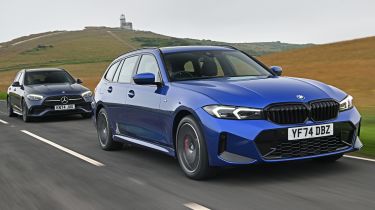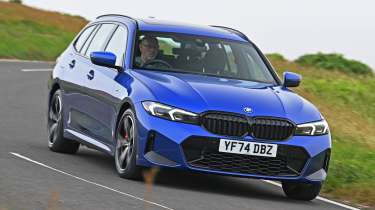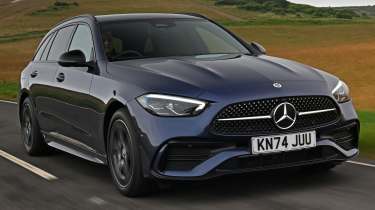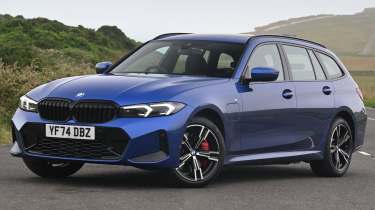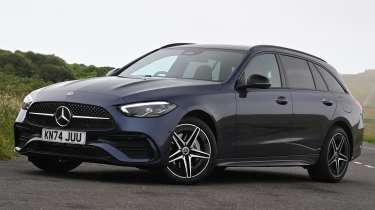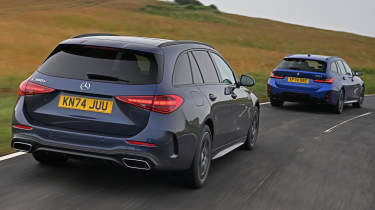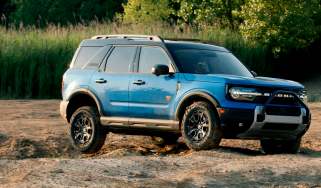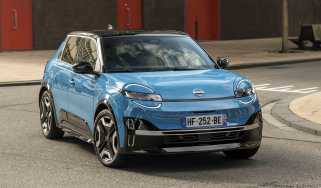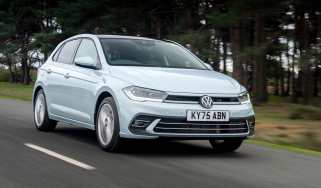BMW 330e vs Mercedes C 300 e: hybrids fight for the ultimate estate crown
Premium BMW 3 Series and Mercedes C-Class plug-in hybrid estates lock horns. Is one loads better than the other?
Upmarket estate cars have always been popular. In recent years they have become the go-to alternative to the SUV, often delivering more usable space, as well as a more sophisticated and sporty drive.
A pioneer of the breed is the BMW 3 Series Touring. It was first introduced with the E30 generation and has remained popular with buyers ever since. The 330e plug-in hybrid joined the line-up with the arrival of the current seventh-generation G20 model; this version is designed to be attractive to company-car users, thanks to its mix of added practicality and low emissions that don’t demand EV-style compromises in range.
The 3 Series Touring’s arch-rival in the sector is the Mercedes C-Class Estate. It’s also available as a plug-in hybrid, called the C 300 e, and just like the BMW, the evolution of its PHEV powertrain has boosted its efficiency and given it a longer all-electric range.
Thanks to changes in company-car taxation, these petrol models are edging closer to EVs in terms of Benefit-in-Kind costs, but do they also make sense as practical family holdalls? There’s only one way to find out, as we pitch these executive load luggers head to head.
BMW 330e Touring
| Model | BMW 330e Touring M Sport |
| Price: | £48,985 |
| Powertrain: | 2.0 turbo 4cyl PHEV, 288bhp |
| 0-62mph: | 6.0 seconds |
| WLTP efficiency: | 43.2mpg (with flat battery) |
| Annual VED: | £620 |
The 330e estate uses the same plug-in hybrid drivetrain as the saloon, with updates in 2024 boosting its efficiency. There’s a 2.0-litre turbocharged petrol engine and an electric motor, while the 12kWh battery that featured when the car first appeared in 2022 has been replaced by a larger 22.3kWh pack. That means a longer all-electric range, plus CO2 emissions as low as 20g/km. As with the standard Touring, Sport and M Sport trims are available, with the latter as tested costing £50,235.
Tester’s notes
As with the whole 3 Series line-up, there’s an £1,800 premium for the 330e Touring when compared with the four-door saloon, but we think that’s a pretty reasonable price to pay.
Used - available now

2026 BMW
i4
33,722 milesAutomaticElectric
Cash £29,990
2021 Lexus
NX Hybrid
33,000 milesAutomaticPetrol2.5L
Cash £26,300
2021 Hyundai
Ioniq hybrid
57,802 milesAutomaticPetrol1.6L
Cash £12,000
2024 Cupra
Formentor
26,570 milesAutomaticPetrol1.4L
Cash £18,900You lose a barely noticeable two-tenths of a second in acceleration, while fuel economy isn’t much poorer, plus you get the extra space of the estate car boot, which offsets the additional room that’s taken up by the PHEV powertrain. Even better is the tailgate glass that opens separately to allow you to access the rear in tight spots to load smaller items in.
Rather than having sport, eco and normal driving modes, the 3 Series Touring has a Driving Experience Control instead, with Personal, Expressive, Sport and Efficient modes, among others. They’re a bit more cryptic because the system adjusts more than just the powertrain.
You get bespoke on-screen graphics, different layouts for the digital dials (some easier to read than others), and the audio system and interior lighting are set up depending on the ‘Experience’ that you’ve selected.
Mercedes C 300 e Estate
| Model | Mercedes C 300 e Estate Urban Edition |
| Price: | £52,220 |
| Powertrain: | 2.0 turbo 4cyl PHEV, 309bhp |
| 0-62mph: | 6.2 seconds |
| WLTP efficiency: | 46.2mpg (with flat battery) |
| Annual VED: | £620 |
Before the BMW gained a bigger battery, the C 300 e held an advantage over the 330e for electric capacity. The petrol side of the set-up is the same as the BMW’s, with a 2.0-litre turbocharged petrol engine, while the electric motor is driven by a 19.5kWh battery.
However, even with the smaller pack, Mercedes claims an all-electric range of 67 miles, eight miles more than the 3 Series. We’re testing the C 300 e Urban Edition, which is the entry point to the range and costs £52,220.
Tester’s notes
One slightly unnerving feature of the C-Class when you first drive it comes when the brake pedal falls away from your foot as the car automatically slows. The adaptive cruise control has a mild-assistance system that is active as soon as you start the car, and the moving pedal is part of this set-up.
The brakes themselves are effective, but we prefer to take control ourselves. The pedal is already softer than the one in the BMW 330e, but we found that deactivating the system provided a more consistent pedal feel.
Speaking to your car to change settings is still an alien concept to UK buyers – it’s something that’s far more prevalent in the Far East. But if you’re happy to ‘talk to yourself’, then it can be an easy way to bypass distracting use of the touchscreen. In the C-Class, simply say “Hey Mercedes” (or press the speak button on the steering wheel) and the system activates. There are other features, such as a personalised greeting when you get in the car, and a vocal reminder if you leave your phone connected to a USB port.
Head to head
On the road
BMW often produces cars that are sportier to drive than rivals, while Mercedes focuses on comfort. That’s exactly the case here, but the 330e manages to deliver a better balance between entertaining handling and cruising comfort that gives it an advantage. Both cars are punchy off the line thanks to their electric assistance, but the weight of the drive battery also means they’re not quite as agile as their petrol counterparts.
Tech highlights
Vast, high-resolution displays are the order of the day here, with the BMW featuring a larger 14.9-inch widescreen panel than the 11.9-inch unit found in the Mercedes. There’s plenty of functionality for both models, although the BMW’s iDrive controller helps to make it more user-friendly than the MBUX system on the C-Class. Both cars feature sharp 12.3-inch driver’s displays that are highly configurable and easy to read.
Price and running
Despite having a smaller battery, the Mercedes has a longer claimed all-electric range than the BMW. Neither car can be run completely flat because a certain amount of charge is retained to help the engine deliver some semblance of efficiency. On our test, the C-Class proved to be more frugal once the battery was low, returning 46.2mpg compared with 43.2mpg for the BMW. The Merc has a larger fuel tank, too.
Practicality
There are sacrifices to be made to include PHEV power, but the 330e has fewer compromises. The 410-litre boot is 50 litres ahead of the C 300 e’s, but is 90 litres down on a petrol 3 Series Touring. At least the separately opening tailgate glass remains. The Mercedes’ 360-litre boot is 130 litres down on a petrol C-Class, plus there’s a high floor to contend with. Neither car has dedicated storage for charge cables.
Safety
There’s a long list of safety kit on both cars, although you have to upgrade to the C 300 e AMG Line Premium Plus to be able to add Merc’s £1,695 Driving Assistance Package Plus. This includes blind-spot assist, active braking, exit warning and route-based adaptive cruise control, among others. BMW includes blind-spot detection in the £1,250 Driving Assistant Professional pack, and it can be added to any version.
Ownership
Everyday costs will be low if you keep the drive battery charged, although only the Mercedes has high-voltage DC charging on offer. A modest 55kW speed means the battery can be replenished in 20 minutes. While the BMW is slower to top up, there are ownership benefits elsewhere. The five-year Service Inclusive package works out at £209 a year, compared with £504 a year for Merc’s three-year offering.
Verdict
Winner: BMW 330e Touring M Sport
Upgrades to the 330e’s drive battery have made it an even more appealing plug-in hybrid. The extra weight of the bigger battery hasn’t had an impact on a driving experience that was a little behind the pure-petrol model anyway, but business users will feel more benefit from the lower emissions the new battery brings.
Even better is that the Touring’s practicality hasn’t been impacted as much as its rival here. Combine this with plenty of passenger space and a raft of user-friendly tech features, and it’s still one of our favourite PHEVs.
Latest BMW 3 Series Touring deals
Runner up: Mercedes C 300 e Estate Urban Edition
There’s plenty of appeal with the C-Class Estate. The premium interior is first rate, the crystal-clear touchscreen and driver’s display feel just as upmarket here as they do in more expensive models, while the low emissions and long all-electric range mean it’ll hold plenty of appeal with business users.
However, as a practical everyday load-lugger, the PHEV model is just too compromised by its large drive battery to be as versatile as its rival here. We’d either stick with the saloon or chose a diesel version of the estate instead.
Latest Mercedes C-Class Estate deals
Prices and specs
| Model Tested | BMW 330e Touring M Sport | Mercedes C 300 e Estate Urban Edition |
| Price from/price as tested | £48,985/£50,235 | £52,220/£52,220 |
| Powertrain and performance | ||
| Engine | 4cyl in-line turbo/1,998cc | 4cyl in-line turbo/1,999cc |
| Combined power | 288bhp | 309bhp |
| Combined torque | 420Nm | 550Nm |
| Transmission | Eight-speed auto/rwd | Nine-speed auto/rwd |
| 0-62mph/top speed | 6.0 seconds/143mph | 6.2 seconds/149mph |
| Fuel tank/battery capacity | 40 litres/22.3kWh | 50 litres/19.5kWh |
| MPG (WLTP)/EV range | 313.9mpg/59 miles | 470.8mpg/67 miles |
| Test economy (with flat battery)/range | 43.2mpg/380 miles | 46.2mpg/508 miles |
| Emissions (WLTP/on test) | 20/151g/km | 13/141g/km |
| Dimensions | ||
| Length/wheelbase | 4,713/2,851mm | 4,793/2,865mm |
| Width/height | 1,827/1,448mm | 1,820/1,462mm |
| Rear knee room | 614-858mm | 615-850mm |
| Rear headroom/elbow room | 980/1,486mm | 950/1,485mm |
| Boot space (seats up/down) | 410/1,420 litres | 360/1,375 litres |
| Boot length/width | 890/945mm | 952/948mm |
| Boot lip/floor height | 620/640mm | 625/685mm |
| Kerbweight/payload/towing weight | 1,895/525/1,500kg | 2,120/535/1,800kg |
| Turning circle | 11.4 metres | 11.1 metres |
| Costs/ownership | ||
| Residual value (after 3yrs/36,000 miles) | £25,771/51.3% | £25,379/48.6% |
| Depreciation | £24,464 | £26,841 |
| Insurance group/quote/VED | 35/£1,148/£620 | 43/£1,116/£620 |
| Three-year service cost | £1,044 (five years) | £1,512 |
| Annual tax liability std/higher rate | £901/£1,803 | £896/£1,793 |
| Basic warranty (miles)/recovery | 3yrs (unlimited)/3yrs | 3yrs (unlimited)/3yrs |
| Driver Power manufacturer position | 8th | 2nd |
| NCAP Adult/child/ped./assist/stars | 97/87/87/76/5 _ (2019) | 93/89/80/82/5 _ (2022) |
| Equipment | ||
| Metallic paint/wheel size | £875-£4,385/18 inches | £655/19 inches |
| Parking sensors/camera | Front & rear/rear | Front & rear/rear |
| Spare wheel/Isofix points | Repair kit/two | Repair kit/two |
| Keyless entry & go/powered tailgate | Yes/yes | Yes/yes |
| Leather/heated seats | £1,300/front | Part-artificial/yes |
| Screen/digital dashboard size | 14.9/12.3 inches | 11.9/12.3 inches |
| Climate control/panoramic sunroof | Three-zone/£1,425 | Two-zone/yes |
| USBs/wireless charging | Four/£1,200 pack | Two/yes |
| Wireless CarPlay/Android Auto | Yes/yes | Yes/yes |
| Blind-spot warning/head-up display | £1,250 pack/£2,100 pack | No/no |
| Adaptive cruise/steering assist | £600/£1,250 pack | No/no |
What we would choose
BMW 330e Touring
The pricey paint options include unique hues and the company’s ‘Frozen’ finishes: essentially matt versions of the standard metallics. Active cruise control is a useful £600 option, and a pop-out tow bar is £1,000.
Mercedes C 300 e Estate
Aside from paint, there aren’t any options available on Urban Edition trim. You have to upgrade to the £60,720 AMG Line Premium Plus to add the £1,695 Driving Assistance Package Plus and £750 Trailer Coupling.
Looking for your next car? You can now search our nationwide dealer network for a choice of great cars on offer right now with new, used and leasing deals to choose from...

